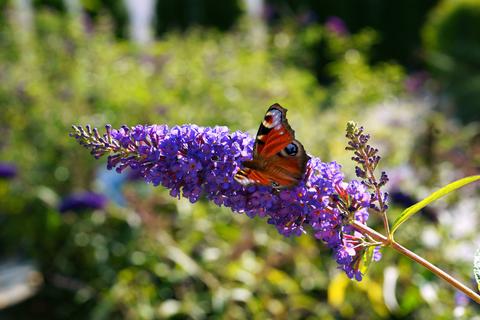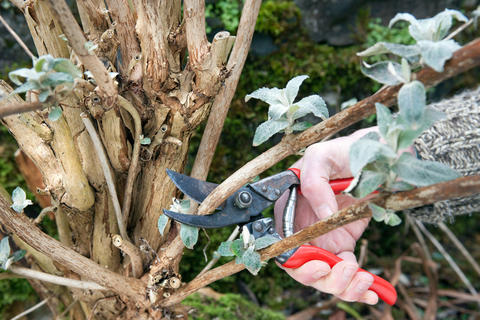Butterfly Bush
The butterfly bush is a truly continuous bloomer and insect magnet. We present a detailed portrait of the shrub and recommend different varieties.
Factsheet
- Growth type
-
- shrub
- Growth height (from)
- from 120 cm to 300 cm
- Growth width (from)
- from 120 cm to 300 cm
- Growth characteristics
-
- funnel-shaped
- sweeping
- upright
- overhanging
- Flower color
-
- purple
- red
- pink
- white
- Flowering time (month)
-
- June to October
- Flower shape
-
- panicles
- Flower characteristics
-
- strongly fragrant
- Leaf color
-
- green
- page format
-
- eilettlich
- Fruit shape
-
- Capsule
- Light
-
- sunny
- Soil type
-
- stony to sandy
- Soil Moisture
-
- dry to fresh
- ph value
-
- alkaline to weakly acidic
- Lime compatibility
-
- lime-tolerant
- Nutrient requirements
-
- moderately nutritious
- Humus
-
- low humus
- Decorative or utility value
-
- Flower Decoration
- Nectar or pollen plant
- Winter Hardness
-
- hardy
- Climate zones according to USDA
-
- 6
- Use
-
- Flowerbeds
- Single position
- free growing hedges
- Group planting
- Planters
- privacy screen
- Flower hedges
- Rebates
- Garden style
-
- cottage garden
- Flower garden
- natural garden
- Stone Garden
- Pot garden
- Bee Friendly
- bee friendly plant
The butterfly bush (Buddleja davidii) is native to China and a member of the family Scrophulariaceae. The plant is sometimes known as summer lilac, but this is misleading: Its upright panicles are indeed reminiscent of the inflorescences of the lilac, but the two shrubs are not closely related. The free-flowering Sungold Butterfly Bush(Buddleja x weyeriana) is a cross between Buddleja davidii and the orange ball tree (Buddleja globosa).
The generic name Buddleja bestowed by Carl von Linné in the middle of the 18th century honored the British botanist Adam Buddle. The butterfly bush has been widespread as a garden plant in Europe for several centuries and has adapted so well to local conditions that in many places it appears in the wild as a neophyte. It tends to inhabit dry, sandy, and gravelly soils, such as abandoned on railway lines and industrial brownfield sites. The butterfly bush is very drought tolerant and grows rapidly, making it more competitive than most native shrubs in this country. Due to the neophyte issue, garden varieties of the butterfly bush can no longer be sold in many parts of Switzerland.
Despite the ecological concerns, the butterfly bush is also an important food-plant for a variety of butterfly species. The peacock butterfly in particular is strongly attracted to the nectar-rich flowers in late summer. But, bumblebees, and bees are often found on the showy blossoms.

The butterfly bush grows upright, forming a funnel-shaped sprawling crown of several lower branches with slightly overhanging side shoots. Its height varies according to the variety: The dwarf specimens are only around 47 inches in height, larger varieties are up to 10 foot tall and almost as wide. Butterfly bushes grow very quickly, especially in nutrient-rich, fresh soils. The bark of the branches is light brown to light gray, peeling off in felt-like stripes with age.
The leaves of the butterfly tree are oppositely arranged. They are ovate to lanceolate, 3.93 to 7.87 inches long, dark green, and felted gray on the underside. In mild winters, the leaves remain on the branches until spring.
The terminal panicles of the butterfly bush are formed on the tips of the new main shoots and on the ends of the upper side shoots. The panicle of the main shoot can be up to 16 inches long in fast-growing varieties. The butterfly bush tends to open its first flowers in July and flowers continuously until the onset of frost. Depending on the variety, flower colors vary between white, mauve, purple, and dark purple. Many varieties of butterfly bush have an intense fragrance.

The butterfly bush produces fruit in the form of capsules. The capsule contains seeds and older varieties often seed themselves. Due to the neophyte issue, however, there are also dwarf varieties with sterile flowers.
The butterfly bush needs a sunny spot in the garden that is as warm as possible. It’s a good idea to protect the plant from cold easterly winds. The shrubs are otherwise extremely drought- and heat-resistant and even do well in urban climates.
Moderately dry, slightly sandy or gravelly soils with medium nutrient concentrations are ideal for the butterfly bush. In these soils, the wood matures well by winter and is less likely to break than in moister, more nutrient-rich garden soils.
Butterfly bushes can be purchased in pots between spring and fall and generally planted out all year round. However, it’s better to do this in spring or early summer, as planting them later than this can cause them to die off in very cold winters. There is no need to prepare the soil provided it is permeable and not too moist. If the soil is very moist, you should work some building sand into the earth around the root ball.
The butterfly bush does not require any special care measures. It flowers luxuriantly each year without fertilizer or regular watering.

You should hard prune the butterfly bush with garden shears in late winter, it will then bloom luxuriantly each year. Simply cut back all main branches, leaving just a few nodes and completely remove thinner side shoots. This results in strong new growth with particularly large panicles. However, don’t leave pruning until late spring – the later you trim the shrub, the later it produces flowers in summer.
The butterfly bush is a great addition to any flower garden. Its flowers attract numerous insects, it is very undemanding, robust, and flowers continuously all summer long. The shrub goes very well in rock gardens and can be integrated – preferably in groups – into summery borders with shrubs and perennials. It looks great alongside, stonecrops, purple coneflower, and other summer bloomers. Dwarf varieties also make outstanding winter-hardy potted plants, and will even forgive you if you forget to water them for a few days.
The wild species of butterfly bush is of little relevance when it comes to garden cultivation. Garden centers exclusively sell cultivars, so-called Buddleja Davidii hybrids. Here is a small selection of recommended varieties:
‘Blue Horizon’: around 10 foot tall; violet blue panicles; very free-flowering
‘Border Beauty’: around 6.5 to 8 foot tall; loosely upright growth habit; up to 18-inch long slender carmine pink panicles
‘Dart’s Ornamental White’: around 8 foot tall; up to 16-inch long panicles with white flowers
‘Foxtail’: up to 9 foot tall; mauve flowers with panicles up to 16-inch long panicles, free and continuously flowering
‘Pink Delight’: old variety, approximately 8 foot tall; up to 16-inch long, densely clustered panicles with purple-pink individual flowers

‘Purple Emperor’: medium growing, around 6.5 foot tall variety; violet, approximately 12-inch long panicles; flowers early with a remarkably strong scent; reblooms well
‘Chip’ hybrids: small growing variety, around 4 foot tall with sprawling crown and sterile violet blue, lilac, purple, or white flowers. These varieties are named after the flower color, for example ‘White Chip’ or ‘Blue Chip’.
The butterfly bush is relatively easy to propagate from cuttings. Take stem cuttings from the side shoots in June and root them in sowing soil in propagation boxes covered with plastic film or covers. You can also propagate the shrub from hardwood cuttings in fall or late winter.
The butterfly bush is generally not affected by diseases and pests. In rare cases, leaves may be damaged by caterpillars and vine weevils, and spider mite infestations can occur. Periods of prolonged warm, humid weather can sometimes cause downy mildew to appear on the plants.

